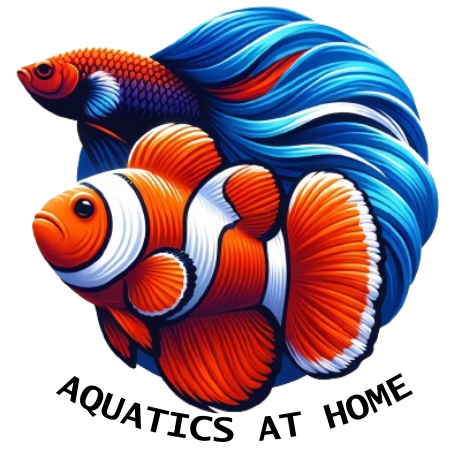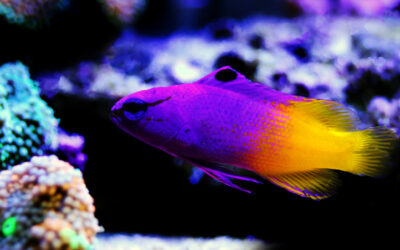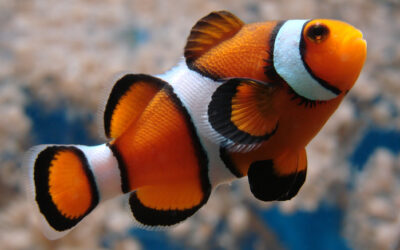The Exciting World of Butterflyfish
Butterflyfish are a group of around 120 species that belong to the family Chaetodontidae. These saltwater fish are known for their stunning colors and intricate patterns, which make them a popular choice for marine aquariums. They have deep, compressed bodies, look somewhat like a disk when viewed head-on, and most species have a concave forehead. The mouth of this fish is small, terminal, and has a protruding snout adapted for picking food items from crevices in coral reefs.
Most butterflyfish species are found in the tropical Atlantic, Indian, and Pacific Oceans. They inhabit coral reefs, displaying a strong association with particular coral species. Their vivid coloration, combined with their active nature and unique swimming style, make them an engaging addition to any aquarium.
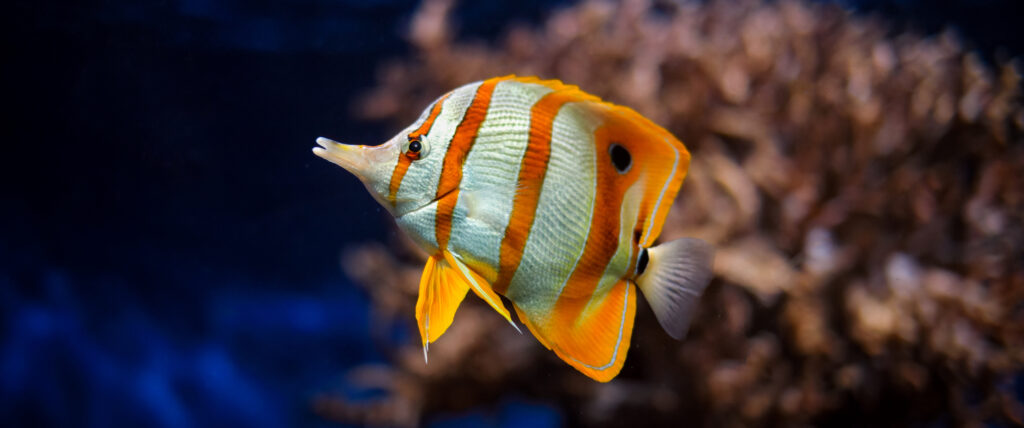
Relevance of Butterflyfish for marine aquarium enthusiasts
Aquarium enthusiasts often select butterflyfish for their vibrant colors and dynamic behavior. Their distinct shape and swimming style can add diversity to the marine aquarium, enhancing its visual appeal. Furthermore, observing their natural behavior can provide enthusiasts with a deeper understanding of marine life dynamics, proving both entertaining and educational.
Despite their beauty, butterflyfish can be challenging to care for, especially for beginners. They have specific dietary needs and are sensitive to changes in water quality. Their care level is often classified as moderate to difficult. However, with the right knowledge and commitment, it is possible for even beginners to successfully maintain these colorful creatures in their aquariums.
Overview of guide content
This guide aims to provide a comprehensive overview of butterflyfish species, their care requirements, and practical tips for maintaining their health in an aquarium environment. The guide will delve into the unique physical characteristics of different species, helping enthusiasts identify their preferred species. It will also provide insights into their natural habitats and how to replicate these conditions within the aquarium.
In addition, the guide will focus on important care practices, including dietary requirements and health maintenance practices. It will also explore common behavior traits among this species and discuss their suitability for community tanks. The guide aims to equip enthusiasts with the knowledge they need to provide optimal care for their butterflyfish.
Diving into Butterflyfish Diversity
Physical characteristics and color patterns
Butterflyfish are renowned for their striking color patterns, which range from bold and bright to subtle and understated. Their bodies are usually adorned with vertical or diagonal stripes, spots, or other markings. They often feature a dark band or “eye spot” on the posterior part of their body, which can confuse predators about the fish’s orientation, providing a survival advantage.
Their shape is also distinctive. Most species have a round, compressed body shape and a continuous dorsal fin. The mouth is small, with brush-like teeth adapted for their specialized diet. Butterflyfish generally range in size from 3 to 8 inches, although some species can reach up to 12 inches in length.
Description and comparison of different species
Among the diverse species, few stand out for their unique characteristics. The Copperband Butterflyfish, for example, is recognized by its bright yellow bands interspersed with white and black. Its long snout is designed to reach into crevices for food. Contrastingly, the Raccoon Butterflyfish has a golden-brown body with dark bands over the eyes and at the base of the tail, resembling a raccoon’s mask.
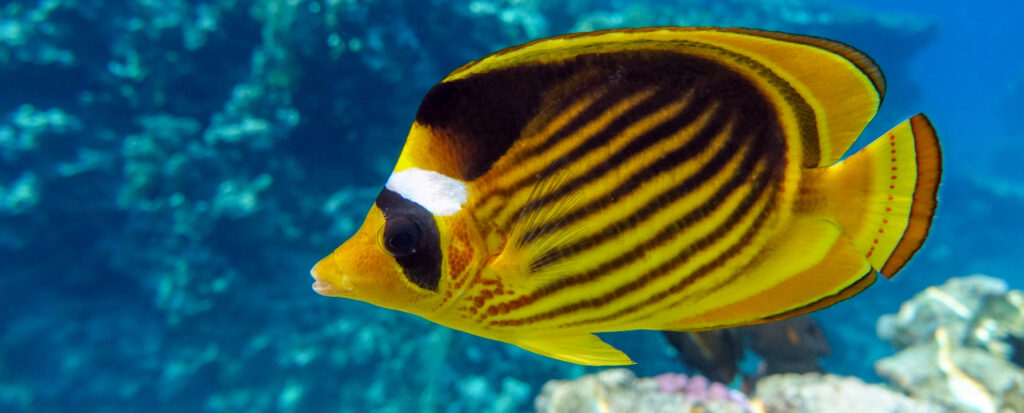
The Threadfin Butterflyfish is another interesting species, with a white body, yellow dorsal fin, and chevron markings. It also has a thread-like extension on the dorsal fin. The Klein’s Butterflyfish, on the other hand, is known for its adaptability and is often recommended for beginners. Its body is yellow-orange with dark lines running diagonally.
Importance of species identification for enthusiasts
Identifying different butterflyfish species is important for several reasons. Each species has its own set of care requirements, including diet, water parameters, and compatibility with other species.
Moreover, the process of identification can enhance the aquarium experience. It can bring a sense of achievement and deepen the enthusiast’s understanding and appreciation of the natural world. It is also a fundamental step in selecting the right species to suit the specific conditions and community of the enthusiast’s aquarium.
Understanding Natural Habitats and Aquarium Conditions
Habitat preferences
Butterflyfish are primarily found in coral reef environments, which provide them with shelter, food, and breeding sites. They generally prefer shallow waters, although some species can be found at depths of up to 200 meters. The water quality in their natural habitats is typically high, with stable temperature and salinity levels.
Most of these fish are territorial and have a home range within the reef. They are diurnal, meaning they are active during the day and rest at night, often in crevices of the reef. Their diet in the wild mainly consists of small invertebrates, coral polyps, and algae.
Essential aquarium conditions
When keeping butterflyfish in an aquarium, recreate their natural habitat as closely as possible. The aquarium should have plenty of live rock for hiding and grazing. The water temperature should be maintained between 72-78°F, with a pH level of 8.1-8.4. Specific gravity should be kept between 1.020 and 1.025.
Good water quality is an absolute must-have, so regular water changes and efficient filtration are necessary. Butterflyfish can be sensitive to changes in water conditions, so parameters should be monitored closely. The aquarium should also have ample space, with a recommended minimum size of 125 gallons for most species.
Translating natural habitats into aquarium settings
Creating a suitable environment for butterflyfish in the aquarium involves mimicking their natural surroundings. This includes not only maintaining the right water conditions but also providing suitable décor. Live rock formations can mimic the structure of coral reefs, providing shelter and grazing opportunities. A variety of caves and crevices can also provide the fish with hiding spots, replicating their natural behavior in the reef.
Lighting should be bright to simulate the clear waters of their natural habitat. However, shady areas should also be provided for rest. As butterflyfish are diurnal, a regular day-night cycle should be maintained in the aquarium. In terms of diet, a varied menu of marine-based meaty foods and vegetable matter should be offered to meet their nutritional needs.
A Beginner’s Guide to Butterflyfish Care Practices
Dietary requirements
Butterflyfish have a specialized diet in the wild, consisting largely of invertebrates, coral polyps, and algae. However, in an aquarium setting, their diet can be supplemented with a variety of marine-based foods. A balanced diet might include small crustaceans, worms, and other meaty foods, as well as some vegetable matter. Some species are planktivores and will appreciate the addition of zooplankton or phytoplankton to their diet.
A variety of commercial foods are available, including frozen, freeze-dried, and pellet foods. It’s important to offer a variety of foods to ensure a balanced diet. Feed them multiple small meals throughout the day, mimicking their natural feeding habits. If you feed them well, you should expect your butterflyfish to be a happy and active citizen of your tank.
Health maintenance practices
Keeping butterflyfish healthy involves more than just feeding them the right diet. It’s also crucial to maintain the right water conditions in the aquarium. Butterflyfish require clean water with stable temperature, pH, and salinity levels. Regular water changes are necessary to remove waste and prevent the buildup of harmful substances.
Butterflyfish can be susceptible to common fish diseases such as ick and marine velvet. Early detection and treatment are key to managing these diseases. Provide plenty of hiding spaces to reduce stress, which can make them more susceptible to illness. Good aquarium management practices, along with a balanced diet, can help keep your fish healthy and vibrant.
Understanding the importance of regular check-ups
Regularly checking the health of your butterflyfish is an essential part of their care. This includes observing their behavior, appetite, and physical appearance. Any changes may indicate a potential health issue. Regular check-ups allow for early detection of problems, increasing the chances of successful treatment.
It’s also important to regularly test the aquarium water for pH, ammonia, nitrite, and nitrate levels. These parameters can impact their health. Regular testing can help detect any issues before they become serious problems. Good aquarium maintenance, coupled with regular check-ups, can ensure a healthy environment.
Navigating Butterflyfish Behavior Traits
Common behavioral patterns
Butterflyfish are known for their active and engaging behavior. They are diurnal, meaning they are active during the day and rest at night. These fish are usually seen swimming openly in the water, often in pairs or small groups. Some species are territorial and may display aggressive behavior towards other fish, especially those of the same species.
Understanding these behavioral traits can help in maintaining a peaceful aquarium. For example, providing plenty of space can help reduce territorial disputes. Also, introducing all fish to the aquarium at the same time can prevent established fish from becoming territorial toward newcomers. Observing the behavior of your butterflyfish can provide valuable insights into their well-being and compatibility with other fish.
Insights into fish interactions within aquariums
Interactions between butterflyfish and other aquarium inhabitants can be complex. While some of them are peaceful and can coexist with a variety of other species, others can be aggressive or territorial. Some of them may also prey on invertebrates, corals, or other small fish.
It’s important to carefully consider the compatibility of butterflyfish with other aquarium inhabitants. Researching the behavior of different species can help you make informed decisions about which species to include in your aquarium. Also, observing the interactions between your butterflyfish and other aquarium inhabitants can provide insights into their compatibility and help you make necessary adjustments.
Assessing the suitability of butterflyfish for community tanks
Many butterflyfish species can be suitable for community tanks, provided their specific needs are met. They typically coexist well with other non-aggressive species of similar size. However, because of their dietary habits, they may not be suitable for reef tanks, as they may eat invertebrates and corals.
It’s crucial to thoroughly research each butterflyfish species before adding them to a community tank. Factors to consider are the their size, temperament, diet, and compatibility with other species. With careful planning and management, butterflyfish can be a colorful and engaging addition to a community tank.
Overcoming Challenges in Butterflyfish Care
Identifying common beginner difficulties
Beginners may face several challenges when caring for butterflyfish. One common issue is meeting their dietary needs. Butterflyfish require a varied diet, and some species are picky eaters. Another common challenge is maintaining the right water conditions. Butterflyfish are sensitive to water quality, and sudden changes can be stressful or even fatal.
These fish can also be susceptible to common fish diseases, and beginners may not recognize the symptoms until it’s too late. Furthermore, their compatibility with other fish can be a challenge, as some can be aggressive or territorial. Understanding these challenges is the first step in overcoming them.
Practical solutions to overcome care challenges
There are practical solutions to the challenges of caring for butterflyfish. To meet their dietary needs, offer a variety of foods and observe what they prefer. Regular water changes and monitoring can help maintain stable water conditions. Installing an efficient filtration system can also improve water quality.
To prevent diseases, quarantine new fish before adding them to the tank and treat any illnesses promptly. When it comes to compatibility, research potential tank mates and observe their interactions to identify any issues. With persistence and a willingness to learn, beginners can successfully care for these beautiful fish.
Importance of perseverance in butterflyfish care
Perseverance is key in caring for any fish. Despite the challenges, the rewards of maintaining a healthy and vibrant butterflyfish are worth the effort. Over time, beginners will gain experience and confidence in their abilities to care for these beautiful creatures.
Perseverance is also important in learning. There is a vast amount of information available about butterflyfish care, and it can be overwhelming for beginners. However, with patience and determination, beginners can acquire the knowledge and skills necessary to provide excellent care for their butterflyfish.
Expanding Butterflyfish Knowledge
Recommendation of further reading resources
Further reading is an excellent way to expand your knowledge about butterflyfish care. Books such as “The Conscientious Marine Aquarist” by Robert M. Fenner and “Marine Fishes” by Scott W. Michael provide comprehensive information on marine aquarium care, including detailed sections on butterflyfish. These books offer in-depth insights into butterflyfish behavior, diet, and health.
Online resources, too, can be a treasure trove of information. Websites such as FishBase and the Reef App offer extensive databases on various fish species, including butterflyfish. These platforms provide detailed species profiles, care guides, and the latest research findings. Always remember to use reliable sources to ensure the accuracy of the information.
Online communities for marine aquarium enthusiasts
Joining online communities can be beneficial for both beginner and experienced marine aquarium enthusiasts. Forums such as Reef Central and Marine Aquariums South Africa offer platforms where enthusiasts can share experiences, ask questions, and learn from each other. These communities often have specific sections dedicated to butterflyfish care.
Similarly, social media groups focused on marine aquariums can be a valuable resource. These groups often feature discussions, photos, and videos that can provide practical insights into butterflyfish care. The shared experiences of other enthusiasts can often provide solutions to common problems and inspire new ideas.
Importance of continuous learning in butterflyfish care
Continuous learning is vital in butterflyfish care. As you gain more experience, you’ll learn to understand the unique behaviors and needs of your butterflyfish. You’ll also learn to anticipate potential problems and address them effectively. This process of learning and adapting is what makes aquarium keeping a fascinating and rewarding hobby.
Continuous learning also keeps you updated on the latest research and advancements in aquarium care. This knowledge can help you improve your care practices and ensure the well-being of your butterflyfish. Therefore, always remain curious and open to learning. This commitment to continuous learning is the key to successful butterflyfish care.
Fostering a Positive Aquarium Experience
Maintaining a motivational tone
Keeping a positive and motivational mindset is essential in butterflyfish care. Remember that challenges are part of the learning process. Each hurdle you overcome enhances your skills and knowledge, leading to a more rewarding aquarium experience. Celebrate your successes, no matter how small they might seem.
Always strive to provide the best care for your butterflyfish. Seeing your butterflyfish thrive is the best reward for your efforts. This positive feedback loop can keep you motivated and engaged in your aquarium hobby.
Encouragement for persistence in aquarium care
Persistence is key in aquarium care. Challenges may arise, but with patience and determination, they can be overcome. Every problem you solve brings you one step closer to creating a healthy and vibrant environment for your butterflyfish.
Remember that every aquarium enthusiast, even the most experienced ones, started as a beginner. They, too, faced challenges and made mistakes along the way. So, don’t be discouraged by initial difficulties. With persistence and the willingness to learn, you’ll become more proficient in butterflyfish care.
Reassuring beginners on the journey ahead
As a beginner, it’s normal to feel overwhelmed by the complexities of butterflyfish care. However, remember that every journey begins with a single step. The knowledge and skills required for butterflyfish care will come with time and experience.
You’re not alone on this journey. There are numerous resources and communities available to provide support and guidance. With patience, determination, and a passion for learning, you can create a thriving marine aquarium that your butterflyfish will love.
Reflecting and Advancing
Key takeaways from the guide
This guide has provided comprehensive information on butterflyfish care, from understanding their dietary needs to managing their health, observing their behavior, and overcoming care challenges. It’s important to remember that butterflyfish require a balanced diet, clean water, regular health checks, and a peaceful environment. Each species has its own unique requirements, and understanding these is crucial for their well-being.
Another key takeaway is the importance of continuous learning. The more you learn about butterflyfish, the better equipped you’ll be to provide excellent care. Always remain curious and open to new knowledge and experiences.
Encouragement for continuous exploration
There are over 100 species of butterflyfish, each with its own unique colors, patterns, and behaviors. Exploring different species can be a fascinating journey. It can also help you choose the right species for your aquarium based on their specific needs and compatibility with other species.
Exploring different butterflyfish species is not just about adding variety to your aquarium. It’s also about understanding and appreciating the diversity of marine life. This exploration can enrich your aquarium experience and deepen your connection with the marine world.
Inspiring action towards a thriving marine aquarium
Creating a thriving marine aquarium is a rewarding journey, one that requires patience, dedication, and a passion for learning. With the right approach and mindset, you can create a vibrant underwater world for your butterflyfish to thrive.
Remember, every step you take towards improving your aquarium is a step towards creating a better environment for your butterflyfish. So, let this guide inspire you to take action, learn more, and create a thriving marine aquarium that you can be proud of.
Key Terminology of Butterflyfish Care
Understanding the Importance of Key Terms
Understanding common terms related to butterflyfish care can enhance your ability to care for these beautiful creatures. It allows you to better comprehend care guides, participate in discussions with other enthusiasts, and make informed decisions about your aquarium. Furthermore, it can enrich your experience as a marine aquarium hobbyist and deepen your connection with the marine world.
Glossary of Key Terms
Algae: A simple, non-flowering aquatic plant of a large group that includes seaweeds. Some butterflyfish species consume algae as part of their diet.
Aquarium Cycling: The process of establishing beneficial bacterial colonies in your aquarium to break down waste and maintain water quality.
Butterflyfish: A group of brightly colored marine fish in the family Chaetodontidae, known for their beautiful patterns and colors.
Community Tank: An aquarium that houses multiple species of fish that are compatible in terms of size, diet, and temperament.
Corals: Marine invertebrates within the class Anthozoa of the phylum Cnidaria. They typically live in compact colonies, and many species are consumed by butterflyfish.
Diurnal: Active during the day. Butterflyfish are diurnal.
Ich (Ick): A common disease in fish, also known as white spot disease, caused by a parasite.
Invertebrates: Animals that do not have a backbone. Some butterflyfish species consume invertebrates.
Marine Velvet: A parasitic disease in marine fish, also known as velvet disease, which is common in aquarium fish, including butterflyfish.
Nitrate: The end product of the nitrogen cycle, which can be harmful to fish in high concentrations.
Nitrite: A toxic compound produced by beneficial bacteria as they break down ammonia in the aquarium.
Planktivores: Animals that feed on plankton. Some butterflyfish species are planktivores.
Quarantine Tank: A separate tank where new fish are kept for a period of time to observe them for signs of disease before being introduced to the main tank.
Reef Tank: An aquarium that mimics the conditions of a coral reef, typically housing various fish and invertebrate species.
Salinity: The saltiness or dissolved salt content of a body of water. It’s crucial to maintain the correct salinity in a marine aquarium.
Water Parameters: The various chemical and physical properties of aquarium water that need to be monitored and adjusted to keep fish healthy, including pH, temperature, salinity, ammonia, nitrite, and nitrate levels.
Zooplankton: Tiny aquatic animals that drift with the current or swim weakly, often consumed by planktivore butterflyfish.

About the Author
With decades of experience, James shares his extensive knowledge in aquatics through this website, covering a broad series of topics related to the pond and aquarium hobby. Aiming to guide both beginners and experienced hobbyists alike, his goal is to help educate aquatic enthusiasts for the long-term betterment of the hobby as well as the environment. Learn More >>
Exploring Basslets for Your Marine Aquarium
Disclaimer: This blog shares my personal experiences, research, and insights as an aquatics hobbyist. While I strive to provide accurate information, please consult a professional or your local fish store for tailored advice on your specific tank setup. Remember,...
The Six Line Wrasse: A Comprehensive Guide to Care and Keeping
Disclaimer: This blog shares my personal experiences, research, and insights as an aquatics hobbyist. While I strive to provide accurate information, please consult a professional or your local fish store for tailored advice on your specific tank setup. Remember,...
The Essential Clownfish Care Guide
Disclaimer: This blog shares my personal experiences, research, and insights as an aquatics hobbyist. While I strive to provide accurate information, please consult a professional or your local fish store for tailored advice on your specific tank setup. Remember,...
